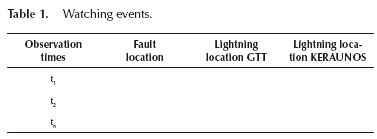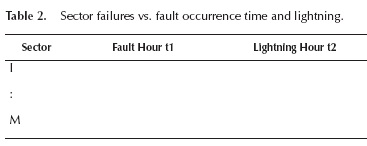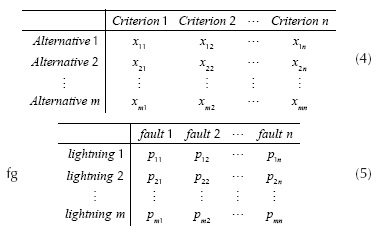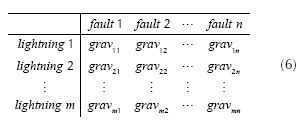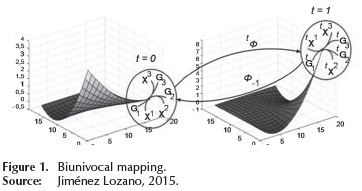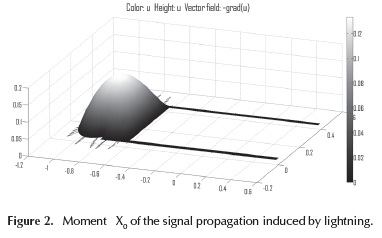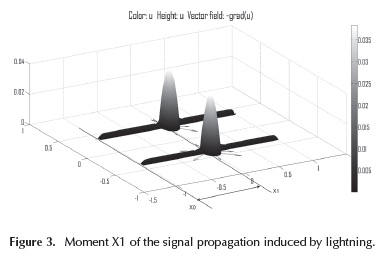Serviços Personalizados
Journal
Artigo
Indicadores
-
 Citado por SciELO
Citado por SciELO -
 Acessos
Acessos
Links relacionados
-
 Citado por Google
Citado por Google -
 Similares em
SciELO
Similares em
SciELO -
 Similares em Google
Similares em Google
Compartilhar
Ingeniería e Investigación
versão impressa ISSN 0120-5609
Ing. Investig. vol.35 supl.1 Bogotá dez. 2015
https://doi.org/10.15446/ing.investig.v35n1Sup.53457
DOI: http://dx.doi.org/10.15446/ing.investig.v35n1Sup.53457
Proposal for an automatic system correlation between failures on electrical distribution lines and atmospheric lightning discharges
Propuesta de un sistema automático de correlación entre fallas en líneas de distribución eléctrica y descargas atmosféricas
V. Henao-Céspedes1, E.A. Cano-Plata2, and L.F. Díaz-Cadavid3
1 V. Henao Cespedes, Ph.D student at Universidad Nacional de Colombia, Manizales. Affiliation: Professor at Universidad Católica de Manizales.170003 Colombia.
E-mail: vhenaoc@unal.edu.co
2 E. A. Cano Plata. Affiliation: Full Professor at Universidad Nacional de Colombia, Manizales, 170003 Colombia.
E-mail: eacanopl@unal.edu.co
3 L. F. Diaz Cadavid. Affiliation: Associate Professor at Universidad Nacional de Colombia, Manizales, 170003 Colombia.
E-mail: lfdiazc@unal.edu.co
How to cite: Henao-Céspedes, V., Cano-Plata, E.A., & Díaz-Cadavid, L.F. (2015). Proposal for an automatic system correlation between failures on electrical distribution lines and atmospheric lightning discharges. Ingeniería e Investigación, 35(Sup1), 104-109. DOI: http://dx.doi.org/10.15446/ing.investig.v35n1Sup.53457
ABSTRACT
This paper presents a proposal for the development of an automatic system correlation between two variables, one represented by the failures on the electrical distribution lines during a storm process and another one represented by atmospheric discharges (lightning) that happen in this process. Initially, in order to define if the failure is caused directly or indirectly by an electrical impact generated by lightning, a space-time correlation is proposed. With the obtained data a decision matrix is proposed, using an entropy method to assign weights to the failures in order to determine its severity and therefore its priority of attention. On the other hand, taking into account that the time window of observation is perhaps the most relevant parameter in the proposed correlation system, this article shows part of a simulation proposed for its calculation as well as the mathematical bases that were used as a support for it.
Keywords: Lightning, correlation, failures in distribution lines, method of entropy, decision making.
RESUMEN
El presente artículo plantea una propuesta para el desarrollo de un sistema automático de correlación entre dos variables, una representada por las fallas acaecidas en las líneas de distribución eléctrica en un proceso de tormenta y otra representada por las descargas atmosféricas (rayos) presentadas en dicho proceso. Inicialmente, para definir si la falla es causada directa o indirectamente por un impacto eléctrico generado por un rayo, se propone una correlación espacio-temporal. Con los datos obtenidos se propone elaborar una matriz de decisión usando, a su vez, un método de entropía para asignar pesos a las fallas con el fin de determinar su gravedad y por lo tanto su prioridad de atención. Por otro lado, considerando que la ventana de tiempo de observación es quizás el parámetro más relevante en el sistema de correlación propuesto, el artículo muestra parte de una simulación planteada para su cálculo, así como las bases matemáticas utilizadas como soporte de esta simulación.
Palabras clave: Descarga atmosférica, correlación, fallas en líneas de distribución, método entrópico, toma de decisiones.
Received: September 9th 2015 Accepted: October 10th 2015
Introduction
In a country like Colombia where electricity distribution networks are mostly air character (network exposed to the weather), many of the failures are usually due to atmospheric events. Studies (Anaya & Pollitt, 2009) show that main meteorological variables (weather events) that affect the normal operation of the overhead lines are: atmospheric lightning discharges, wind, extreme temperatures, snow, ice, storms, rain and humidity. Statistically, many failures occur during a storm process.
¿But to what extent is the lightning directly or indirectly responsible for the failure?
Electrical service outage during a storm is usually attributed to the direct effect of lightning on the electrical distribution system, leaving out other possible causes generated by weather conditions of the thunderstorm. This motivates the development of an automatic system that allows to define the exact cause of the failure during a storm process, through a correlation space- temporal, between events of failure and the impacts of lightning. In this way, for the developing of such system, the use of computational tools that allow us to acquire information (location and time) of lightning and information of failures on the electrical distribution system simultaneously is necessary.
This development is proposed considering that Colombia is one of the countries with regions of highest keraunic level (Younes & Duarte-Velasco, 2010), and the probability of unfairly blaming lightning as the cause of most failures in the distribution lines may be very high. The above necessarily causes a decrease in the quality of service of operation and maintenance; such aspect can be solved if a module that collects real-time data of the times and locations of lightning is included, and if this module is integrated into the system of supervision and monitoring of the distribution network, looking for a correlation that automatically allows to clarify the real cause of each failure (Anaya & Pollitt, 2009).
The lightning and the electrical distribution System
As has been previously stated, the faults in the electrical distribution system during a storm are not direct responsibility of lightning, because in this process factors other than lightning are presented. One goal of the proposed system is to determine if there is a direct relationship between lightning and the occurrence of a failure on the electrical distribution system in a defined sector.
The way in which lightning can cause network failures is presented in two ways (IEEE std 1410, 2011):
- Direct discharges.
- Voltages induced for nearby discharges.
Damage caused by lightning in the distribution lines may be due to direct downloads on the phase conductors or neutral or ground wires (if there are), or due to indirect discharges that do not directly impact the line but do alter the electromagnetic field around and induce voltages around it (GAMMA Boletín Técnico, 2005).
However, it is difficult to determine whether a direct or indirect stroke caused a distribution line fault, since the damage to facilities, caused by direct strokes, produces similar effects to those from indirect ones (Miyazaki & Okabe, 2009), and this aspect complicates the analysis of causality of the fault.
In Colombia, some operators of distribution of electrical energy, such as the Electricity Company of Bogotá, EEB, have made failure analysis, concluding that a high percentage of failures was undoubtedly due to lightning (Roman-Santos, 1991). This supports the theory that approximately 75 % of faults in power systems are of monophasic type to ground and are the product of flashover during lightning storms (Mohamed & Hawary, 1995).
Considering the above, it is clear that a system that defines the relationship between lightning and the electrical failure would be a very useful tool for planning protections against lightning. In the other hand, this tool will provide data that will lead to evaluate the correct performance of the distribution air lines in presence of lightning.
By the above, the following question arises: ¿How is it possible to discriminate cases in which lightning directly causes faults in the electrical distribution system, from cases when failures are an indirect consequence of lightning?
System development proposal
For the development of the proposed system, the location data and the time data of the faults in the distribution system, as well as the atmospheric lightning discharges, are required. When combining the exact location of line failure with the exact location of lightning and the time of occurrence, it is possible to accurately determine when lightning is the cause of disturbance (Kappennman, 1999).
Consequently, the following steps are proposed as a methodology for system development:
- Perform an automatic correlation between the lightning and the faults, based on::
- Database system for monitoring power quality of the electrical operator in the region.
- Database of lightning events in Colombia provided by the Colombian system KERAUNOS (http://keraunos.co/).
- Perform an entropic assessment of the severity of the failure in order to prioritize its attention.
The correlation will verify if a lightning discharge in an area bears some relation to the occurrence of one failure in the distribution lines in the same area. The databases used for correlation have data associated with time and therefore can be defined as time series, which allows to obtain a better understanding of the mechanism of generation of data, as well as a prediction of future values or the optimal control of the system (University of Würzburg, 2012).
Based on the database, watching events in time table are proposed as follows:
Subsequently, a segmentation of the distribution lines is carried out, obtaining a grid distribution line. Based on that grid, it is possible to relate the failures with the lightning, using the following table:
From Table 2, it is possible to perform a statistical study, obtaining the probabilities associated with the occurrence of a failure due to lightning. If time values t1 and t2 in the i-th sector are equal, there will be a high certainty that the failure was due to lightning; otherwise, the failure will be due to other causes. All faults with different sources will probabilities Pk of occurrence, for which must be defined k possible causes of failure and their probabilities. Based in the event probabilities obtained, a metric of the system efficiency can be calculated in order to define the failures due to less frequent than lightning causes. The efficiency metric is the Shannon entropy associated with the average value of the information (uncertainty of occurrence of an event), and it is directly proportional to the value of the information they can deliver in the event.
Remembering:
where H is the entropy for the set of events L, which is equal to the mathematical expectation of the information provided by the possible events; therefore:
The mathematical expectation is the sum of the probability of each possible event multiplied by the value of the event, in this case the value of the information obtained. Therefore, the entropy is:
System efficiency will be associated with the veracity of the information and the ability to achieve and define the infrequent causes of failures. That is to say to achieve showing when the fault is NOT due to a lightning. The system will have a higher entropy when the faults are not generated by lightning, and null-entropy when all electrical failures are generated by lightning discharges.
Performing an entropy analysis is then possible in order to define the entropy weights associated with the events, and in order to evaluate the provided information and prioritize the care of failures. The weights associated with events may indicate the importance of a certain severity index or even the tendency to certain extent, indicating, in this case, the importance of a failure event (Lia & Xu, 2012). In this way, the importance of the events is leading to the decision theory that can be applied by means of probabilistic models in order to deal with the lack of knowledge on utility functions, subjective preferences and diagnostic situations (Correa et al, 2004). Hence, it is assumed that uncertainty is a result of random phenomena, being indicated to assume the entropy method for deciding the priority of attention of the electrical failures.
The method of entropy is an "objective" method for assigning weights. The essential idea is that the relative importance of the criteria "j" (the electrical failure for to attend) in a given situation for decision (lightning discharge), measured by its "ra" weight, is directly related to the quantity of information that is intrinsically provided by the set of alternatives related to that criterion. For the development of the analysis through the method of entropy a decision matrix is proposed (Hosseinzadeh & Fallahnejad, 2010), as follows:
Where the rows (m) indicate the sector of the lightning detection, the columns (n) are associated with the detection sector of the electrical failure, and in each of the spaces the value of the probability of occurrence of an electrical failure and a lightning discharge are consigned at that point. (Example: P12 probability of a lightning in sector 1 and an event of electrical failure in sector 2). Supported by a statistical study based on the correlation system, the probability values of the matrix are obtained. To each of the possible failures, severity criteria for the electrical failures can be assigned, which will define the priority of attention. The severity values of each fault will be reflected in an array like this:
The entropy for the m-th fault can be calculated as (Hosseinzadeh and Fallahnejad, 2010):
Where,  which are values for a normalized matrix k = (Inn)'1 and it is assumed that
which are values for a normalized matrix k = (Inn)'1 and it is assumed that  if
if  .
.
The weight of each entropy is given by:
Where the degree of diversification is obtained as:
An entropy with a value equal zero (0), means that all criteria give a precise indication either credible or not definitely, while an entropic value of 1 means that all criteria give an indication of high diffusivity (Sanchez, 2001). In turn, the weight of entropy is inverse to the value of entropy, and will help the system for it to automatically define which electrical failure must be attended more promptly.
The "time window" and the propagation channel
One of the most important parameters to define the correlation between faults of the distribution lines and the lightning discharges presented during a storm, is the definition of a time window (Wt) by which one can certainly evaluate the responsibility of the lightning as the source of the failure. Let it be noticed that at the time of a lightning strike near the distribution line, an EM pulse which is induced in the distribution line is generated and propagated to a speed υp defined by the distributed parameters which are characteristic to the line. If υp is known, then it is possible to define how long it takes to get the signal that is induced from a starting point to an end point (separated by a distance d), in which there is an element of the distribution network that may fail because of that signal. The time that takes the signal to travel the distance between those points, will be Wt, and the elapsed time between the generation of lightning and the electrical failure must not exceed Wt. For the calculation of Wt, the time of strike is defined as an initial time t0 = 0; as final time tf (Wt), the time of arrival of the induced wave to the first protection element of the distribution network is taken. The method, proposed and developed by our research group (CTT, Grupo de Investigación en Telemática y Telecomunicaciones) for the calculation of the Wt, is based on a simulation of signal propagation through the distribution line (propagation channel). The mathematical support that has been used to model the propagation channel and define the time window is as follows:
Initially assume a continuous space in which the reference configuration °Δ and the spatial configuration are known 1Δ, as shown in Figure 1.
Then, the following was defined:
- An arbitrary coordinate system in the spatial configuration tXa with covariant basis vectors tga and contravariant basis vectors tga.
- An arbitrary coordinate system in the reference configuration {Xa} with covariant basis vectors GA and contravariant basis vectors GA.
- A system of convective coordinates {θi} in which the spatial configuration has covariant basis vectors tgi and contravariant basis vectors, tgi and in the reference configuration has covariant basis vectors Gi and contravariant basis vectors Gi.
Assume the existence of a biunivocal mapping:
and a reverse mapping:
That is, the movement indicated in Figure 1 was assumed to be a regular movement, corresponding to the course change of geometry in the presence of a lightning discharge in the propagation channel model. This case comes from the formal notion of regular movement and corresponds to the intuitive notion of movements in which the interpenetration does not happen.
Note: With the bi-univocal mapping (Figure 1) based on continuum mechanics, the change of the geometry into the presence of a lightning strike is detailed, which will allow to mathematically simulate the point of lightning induction into the distribution line.
Restricting the Euclidean space problem, it can be considered that is a vector.
Using a descriptor of X position for the propagation channel, where any point of this channel is given by P = (x1,x2,x3), for a Xt reference configuration, all processes can be described. The position vector of the current or arbitrary configuration is given by  , and it can be obtained by setting the displacement U as well:
, and it can be obtained by setting the displacement U as well:
In order to characterize the deformation on two points (P and Q) in the middle of the traveling of the wave of electromagnetic propagation, the two coordinates for each point are considered as XP and XQ vectors positioned in the configurations of Xt reference, and they can be related as functions based on the geometric observations of Figure 1.
Constitutive relation:
Assume that there is a problem in which only the variable representing the electric field is considered; the constitutive relation can then be established:
Where  is a tensor function, and in this particular case is the conductivity function which maps the invertible space in two points of the symmetric space. Importantly,
is a tensor function, and in this particular case is the conductivity function which maps the invertible space in two points of the symmetric space. Importantly,  depends on the reference configuration. In this regard and taking into account that only the electrical characteristics are studied, it is understood that the principle of equi-presence is respected and the phenomenological factors of the quantum mechanics are not considered.
depends on the reference configuration. In this regard and taking into account that only the electrical characteristics are studied, it is understood that the principle of equi-presence is respected and the phenomenological factors of the quantum mechanics are not considered.
To study the objectivity of the formulation, the spatial configuration is considered in two coordinate systems: one fixed (X) and another moving X*, as shown in Figure 1. Since the current density tensor is an objective spatial tensor, it can be displayed as:
Where  is an orthogonal tensor, as well as the electric field is an objective tensor,
is an orthogonal tensor, as well as the electric field is an objective tensor,  . Furthermore, as
. Furthermore, as  is valid for any orthogonal relationship, it will also be valid for the polar decomposition; that is to say:
is valid for any orthogonal relationship, it will also be valid for the polar decomposition; that is to say:
 or what would be the same: 2. presents the principle of the material which imposes that not affected by change of coordinates or reference. The material will then be represented by conductivity.
or what would be the same: 2. presents the principle of the material which imposes that not affected by change of coordinates or reference. The material will then be represented by conductivity.
Equilibrium equations
Equation (13) is the equilibrium equation in the spacial configuration, where J is the current vector per unit volume of the spatial configuration. (Cano Plata & Ramirez Castaño, 2010) present a detailed development. From this reference, it can be highlighted that:
In the coordinate system {'Xα}, the divergence of J is given by (13) as the Maxwell relationship of continuity; in this, the constitutive relations appear, among others Ohm's Law (Cano Plata & Ramirez Castaño, 2010) as a basis for development of the theory of propagation.
Given that  is a vector, we can find its representation in the reference configuration
is a vector, we can find its representation in the reference configuration
An also in
and considering Equations (11 through 14) we obtain:
This is written as (Jimenez Lozano, 2015):
A solution to Equation (19) can be presented through the finite element method. Using the MATLAB tool PDETOOL, (MathWorks, 2015) a result like that can be displayed as shown in Figures 2 and 3.
Figures 2 and 3 allow to visualize how in an initial time, at an X0 point in the space under observation, once the atmospheric discharge impact is presented, the LEMP (Lightning electromagnetic pulse) is induced to the distribution lines. Later, in a second instant, the load induced by lightning propagate until a X1 point in the distribution line is observed, at which one can find an element of the distribution network that has failed because of the lightning presented. From Figure 3 it follows that if values of the propagation velocity and the length of the distribution line between the impact point (X0) and the nearest distribution network element (X1) are known, and it is then possible to calculate the time window Wt required to perform the proposed correlation.
Conclusions
The methodology and mathematical support for the implementation of the proposed system of automatic correlation between the events of faults in the electrical distribution system and lightning, has been raised.
The present proposal suggests an application of the theorem of Shannon entropy and of the theory of decision-making as a mathematical method for the prioritization process in the care of failures that occurred in the electrical distribution system.
The mathematical support for the "time window" calculation and a simulation of the propagation channel (distribution lines) which was developed using the finite element method is shown.
Figures 2 and 3 show how the proposed mathematical apparatus becomes an effective tool for the calculation of the time window of events observation, being this parameter the most relevant to perform the automatic correlation system proposed in the present paper.
Acknowledgements
The authors wish to thank the Universidad Nacional de Colombia - Manizales branch, to the Universidad Católica de Manizales and to the Administrative Department of Science Technology and Innovation (Departamento Administrativo de Ciencia, Tecnología e Innovación) COLCIENCIAS.
References
Anaya, K.L., & Pollitt, M.G. (2009). Does Weather Have an Impact on Electricity Distribution Efficiency Evidence from South America, EPRC Working Paper 1404, Cambridge Working Paper in Economics. [ Links ]
Cano Plata E.A., & Ramirez Castaño J.S. (2010). Sistemas de Puesta a Tierra Diseñando con IEEE-80 Evaluando con MEF. Manizales: Ed. Universidad Nacional de Colombia. [ Links ]
Correa, G. J., & Anaya, E., & Peña, G. E. (2004). Implementación computacional para el apoyo a la toma de decisiones, utilizando metodologías difusas. Avances En Sistemas E Informática, Vol 2, pp. 19 - 27. [ Links ]
GAMMA. (2005). Consideraciones sobre el comportamiento de las líneas de transmisión ante descargas atmosféricas, GAMMA Boletín Técnico. [ Links ]
Hosseinzadeh, F., & Fallahnejad R. (2010). Imprecise Shannon's entropy and multi attribute decision making, Open Access Journal. Recovered on June 15, 2015 of http://www.mdpi.com/1099-4300/12/1/53. [ Links ]
IEEE. (2011). IEEE Guide for improving the lightning performance of electric power overhead distribution lines, IEEE 1410. [ Links ]
Jia, Y., & Xu, Z. (2012). Risk Assessment Based on Information Entropy of Cascading Failure in Power Systems. Power and Energy Society General Meeting, IEEE, pp. 1-5. [ Links ]
Jiménez Lozano, G. (2015). Dinámica y optimización de los sistemas de puesta a tierra. (PhD Thesis, Universidad Nacional de Colombia Sede Manizales). [ Links ]
Kappennman, J.G. (1999). Distribution lightning fault correlation & advanced applications of lightning data. IEEE T&D Conference. [ Links ]
Miyazaki, A T., & Okabe, S. (2009). A Detailed Field Study of Lightning Stroke Effects on Distribution Lines. IEEE Transactions on Power Delivery, Vol. 24, No 1, pp. 352-359. DOI: 10.1109/TPWRD.2008.2002672. [ Links ]
Mohamed, E., & Hawary, E. (1995). Electrical Power Systems. New Jersey: John Wiley & Sons. DOI: 10.1109/59.373948. [ Links ]
Roman-Santos, F. (1991). Análisis de las fallas en transformadores causadas por la operación del pararrayos ante sobre tensiones externas, Revista Ingeniería e Innovación, Vol 22, pp. 34-46. [ Links ]
Sánchez, R. (2001). La toma de decisiones con múltiples criterios: Un resumen conceptual y teórico. Documento de trabajo del CEPLAC. [ Links ]
The MathWorks. (2015). Partial Differential Equation Toolbox User's Cuide. [ Links ]
University of Würzburg. (2012). A firts course on the time series analysis by Chair of Statistics. Ed. University of Würzburg. [ Links ]
Younes, C., & Duarte-Velasco, O.G. (2010). Correlación de parámetros del rayo con características geográficas y meteorológicas. Bogotá: Ed. Universidad Nacional de Colombia. [ Links ]













